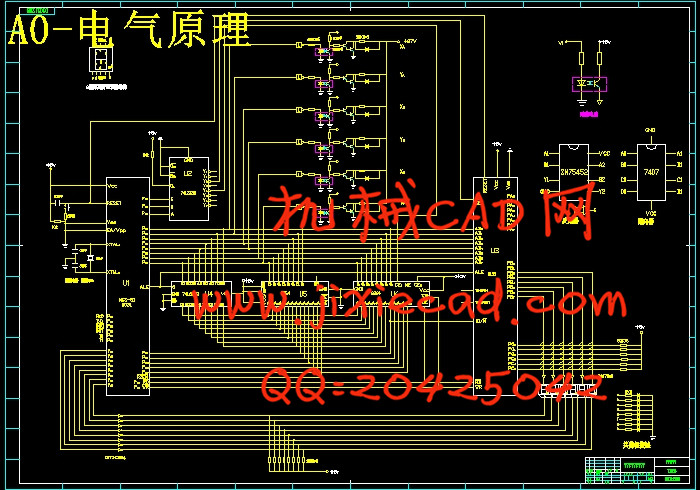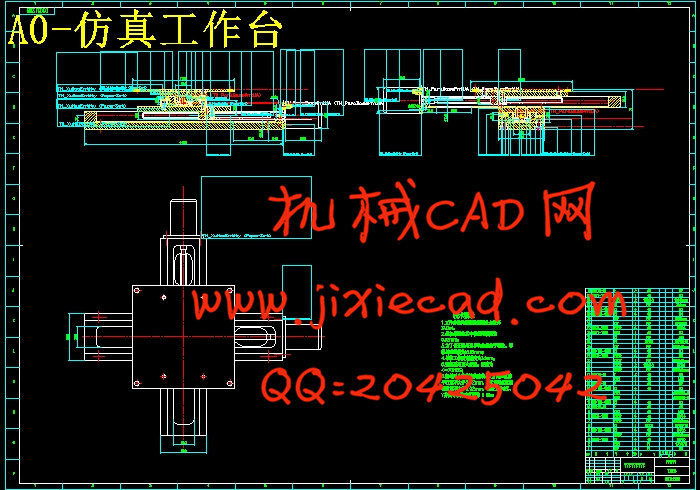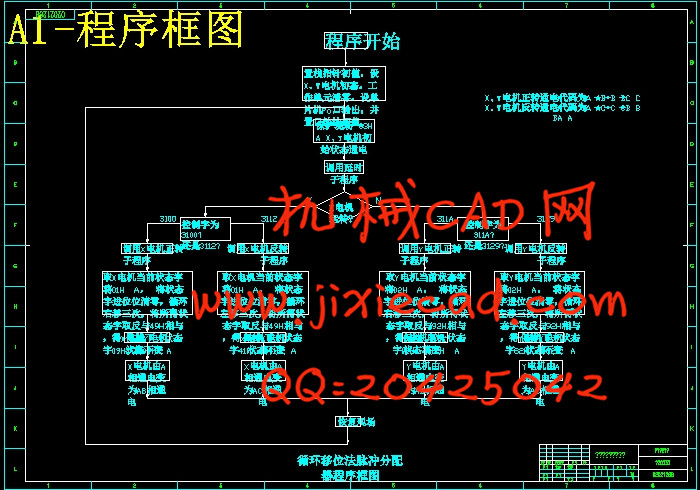设计简介
数控铣床工作台仿真实验系统的开发
摘要
本文主要是设计一套以MCS—51单片机为主控制器的数控铣床工作台仿真实验系统,首先对数控技术的发展作了分析和总结,探讨了数控机床的开放化、智能化、高精度、高速度和网络化的发展趋势;着重分析了单片机数控系统的控制原理,指出了设计数控系统的一般方法和步骤,并阐述了MCS—51系列单片机的功能以及在机床数控系统中所发挥的作用;设计开发了系统机械结构以及控制系统的I/O接口电路、步进电机驱动电路;通过编写汇编程序,从而实现系统设计要求。开发的这套系统可以作为一套实验室设备,对机床数控化改造、数控技术的教学和研究有深远意义。
关键字: 单片机 铣床工作台 步进电机 接口电路 汇编程序
The Simulating Experiment System for Numerical Control of Milling Machine’s Worktable Exploitation
ABSTRACT
In this article, a set of numerical control of milling machine worktable experiment system for teaching based on single chip microprocessor for MCS—51 is designed. First, the CNC system model and characteristics based on microcomputer and status of CNC in China are presented. The development trends about open architecture, intelligence, suppression, high speed and network of CNC are analyzed and explain the function of single chip microprocessor and their calling into play in the CNC, and controlling principle of single chip microprocessor for MCS—51. This article introduces the methods and steps of the digital control system design. Emphasis is given to I/O circuit, stepping motor drive and authorized assembler and carry out the system designing request. The system offer a set of equipment for teaching, and is designed for teaching as a set of experiment or has a great affect to the digital control reform of the machine tool.
KEY WORDS: Single Chip Microprocessor; Worktable of Milling Machine; Stepping Motor, Interface Circuit, Assembler
目 录
第1章 绪论 ………………………………………………………………… 1
1.1 引言 ………………………………………………………………… 1
1.2 国内外数控技术的现状及发展趋势 ……………………………… 1
1.3 单片机技术及其发展趋势 ………………………………………… 3
第2章 数控铣床工作台总体方案设计 …………………………………… 4
2.1总体方案设计的内容 ……………………………………………… 4
2.2 控制系统的选择 …………………………………………………… 4
2.3 系统运动方式的选择 ……………………………………………… 5
2.4 伺服系统的选择 …………………………………………………… 5
2.5 传动及导向元件选择 ……………………………………………… 6
第3章 工作台机械结构设计 ……………………………………………… 7
3.1 工作台结构设计的内容和任务 …………………………………… 7
3.2 确定系统的脉冲当量 ……………………………………………… 8
3.3 伺服电机的确定及选择 …………………………………………… 8
3.4 传动及导向元件的设计、计算及选用 …………………………… 10
3.4.1传动元件的设计………………………………………………10
3.4.2导向元件的设计………………………………………………10
3.5 计算机绘制工作台结构装配图…………………………………… 12
第4章 工作台控制系统硬件电路设计 …………………………………… 13
4.1 控制系统硬件电路设计的内容 ………………………………… 13
4.2 确定系统硬件电路设计的整体方案……………………………… 13
4.3主CPU的选择……………………………………………………… 15
4.4 8031单片机管脚功能及特点……………………………………… 16
4.5 存储器扩展电路的设计…………………………………………… 20
4.5.1 程序存储器扩展…………………………………………… 20
4.5.2 地址锁存器74LS373………………………………………21
4.5.3 数据存储器的扩展 ……………………………………… 22
4.5.4 译码电路 ………………………………………………… 22
4.6 I/O扩展电路的设计……………………………………………… 23
4.6.1 8155扩展芯片…………………………………………… 23
4.6.2 键盘及其接口电路……………………………………… 24
4.6.3 显示器及其接口电路…………………………………… 25
4.7步进电机驱动电路设计………………………………………… 27
4.7.1 功率放大电路…………………………………………… 27
4.7.2 隔离电路………………………………………………… 28
4.7.3 步进电机驱动电路……………………………………… 29
4.8其它辅助电路设计……………………………………………… 30
4.8.1 8031时钟电路设计……………………………………… 30
4.8.2 复位电路………………………………………………… 30
第5章 控制系统软件设计…………………………………………………32
5.1控制系统软件设计的内容及方法…………………………………32
5.1.1 程序设计的内容…………………………………………… 32
5.1.2 程序设计的方法及要求…………………………………… 32
5.2环形分配器软件设计………………………………………………33
5.2.1步进电机转速控制………………………………………… 33
5.2.2 编制环形分配器程序及框图………………………………35
5.3逐点比较法直线插补程序设计………………………………… 38
5.3.1 逐点比较法直线插补(第一象限)………………………38
5.3.2 编制第一象限直线插补主程序……………………………39
5.3.3 逐点比较法圆弧插补程序设计……………………………41
结论及展望……………………………………………………… 46
参考文献………………………………………………………………… 47
致谢……………………………………………………………………… 49
摘要
本文主要是设计一套以MCS—51单片机为主控制器的数控铣床工作台仿真实验系统,首先对数控技术的发展作了分析和总结,探讨了数控机床的开放化、智能化、高精度、高速度和网络化的发展趋势;着重分析了单片机数控系统的控制原理,指出了设计数控系统的一般方法和步骤,并阐述了MCS—51系列单片机的功能以及在机床数控系统中所发挥的作用;设计开发了系统机械结构以及控制系统的I/O接口电路、步进电机驱动电路;通过编写汇编程序,从而实现系统设计要求。开发的这套系统可以作为一套实验室设备,对机床数控化改造、数控技术的教学和研究有深远意义。
关键字: 单片机 铣床工作台 步进电机 接口电路 汇编程序
The Simulating Experiment System for Numerical Control of Milling Machine’s Worktable Exploitation
ABSTRACT
In this article, a set of numerical control of milling machine worktable experiment system for teaching based on single chip microprocessor for MCS—51 is designed. First, the CNC system model and characteristics based on microcomputer and status of CNC in China are presented. The development trends about open architecture, intelligence, suppression, high speed and network of CNC are analyzed and explain the function of single chip microprocessor and their calling into play in the CNC, and controlling principle of single chip microprocessor for MCS—51. This article introduces the methods and steps of the digital control system design. Emphasis is given to I/O circuit, stepping motor drive and authorized assembler and carry out the system designing request. The system offer a set of equipment for teaching, and is designed for teaching as a set of experiment or has a great affect to the digital control reform of the machine tool.
KEY WORDS: Single Chip Microprocessor; Worktable of Milling Machine; Stepping Motor, Interface Circuit, Assembler
目 录
第1章 绪论 ………………………………………………………………… 1
1.1 引言 ………………………………………………………………… 1
1.2 国内外数控技术的现状及发展趋势 ……………………………… 1
1.3 单片机技术及其发展趋势 ………………………………………… 3
第2章 数控铣床工作台总体方案设计 …………………………………… 4
2.1总体方案设计的内容 ……………………………………………… 4
2.2 控制系统的选择 …………………………………………………… 4
2.3 系统运动方式的选择 ……………………………………………… 5
2.4 伺服系统的选择 …………………………………………………… 5
2.5 传动及导向元件选择 ……………………………………………… 6
第3章 工作台机械结构设计 ……………………………………………… 7
3.1 工作台结构设计的内容和任务 …………………………………… 7
3.2 确定系统的脉冲当量 ……………………………………………… 8
3.3 伺服电机的确定及选择 …………………………………………… 8
3.4 传动及导向元件的设计、计算及选用 …………………………… 10
3.4.1传动元件的设计………………………………………………10
3.4.2导向元件的设计………………………………………………10
3.5 计算机绘制工作台结构装配图…………………………………… 12
第4章 工作台控制系统硬件电路设计 …………………………………… 13
4.1 控制系统硬件电路设计的内容 ………………………………… 13
4.2 确定系统硬件电路设计的整体方案……………………………… 13
4.3主CPU的选择……………………………………………………… 15
4.4 8031单片机管脚功能及特点……………………………………… 16
4.5 存储器扩展电路的设计…………………………………………… 20
4.5.1 程序存储器扩展…………………………………………… 20
4.5.2 地址锁存器74LS373………………………………………21
4.5.3 数据存储器的扩展 ……………………………………… 22
4.5.4 译码电路 ………………………………………………… 22
4.6 I/O扩展电路的设计……………………………………………… 23
4.6.1 8155扩展芯片…………………………………………… 23
4.6.2 键盘及其接口电路……………………………………… 24
4.6.3 显示器及其接口电路…………………………………… 25
4.7步进电机驱动电路设计………………………………………… 27
4.7.1 功率放大电路…………………………………………… 27
4.7.2 隔离电路………………………………………………… 28
4.7.3 步进电机驱动电路……………………………………… 29
4.8其它辅助电路设计……………………………………………… 30
4.8.1 8031时钟电路设计……………………………………… 30
4.8.2 复位电路………………………………………………… 30
第5章 控制系统软件设计…………………………………………………32
5.1控制系统软件设计的内容及方法…………………………………32
5.1.1 程序设计的内容…………………………………………… 32
5.1.2 程序设计的方法及要求…………………………………… 32
5.2环形分配器软件设计………………………………………………33
5.2.1步进电机转速控制………………………………………… 33
5.2.2 编制环形分配器程序及框图………………………………35
5.3逐点比较法直线插补程序设计………………………………… 38
5.3.1 逐点比较法直线插补(第一象限)………………………38
5.3.2 编制第一象限直线插补主程序……………………………39
5.3.3 逐点比较法圆弧插补程序设计……………………………41
结论及展望……………………………………………………… 46
参考文献………………………………………………………………… 47
致谢……………………………………………………………………… 49





